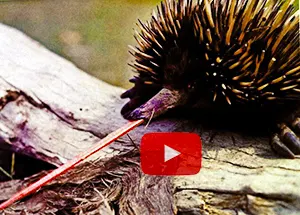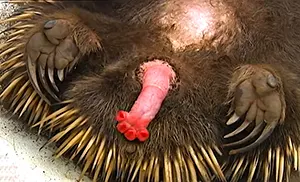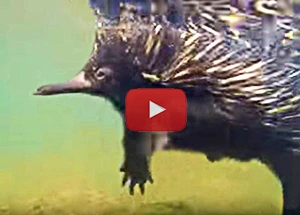Echidna Facts
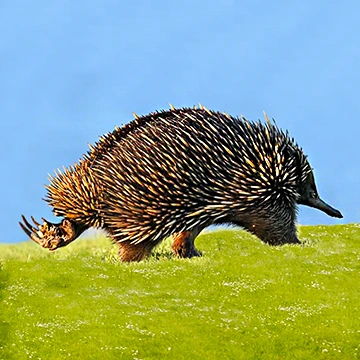
Contents
What is an Echidna?
Meet the echidna, one of nature’s most fascinating oddballs! This spiky, egg-laying mammal (yes a mammal that lays eggs!) may look like a hedgehog, but it’s actually a distant cousin of the platypus. With a long sticky tongue for slurping up ants and electromagnetic sensors to find its prey, the echidna is a true oddball marvel of evolution. Found across Australia and New Guinea, these shy creatures are full of surprises. Undoubtedly, the echidna is one of the coolest critters on the planet!
Echidna Characteristics
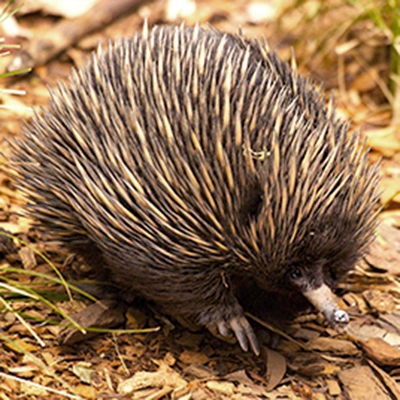
Photo: Echidna's spines, eyes, snout and ear hole
The echidna is 30-45 cm long and weighs 2-7 kilos. It has coarse, reddish to dark brown fur and pointed, hollow keratin spines formed from modified hairs covering its body except for its face, legs, and underside.
• The echidna has a tiny face with small eyes and poor eyesight. However, it has excellent sense of hearing and smell
• It has no external ears, but has funnel-like slits on either side of its head, hidden beneath its fur, that serve the same function.
• The echidna has a slender, elongated, rubbery snout with toothless jaws called a beak.
• Its beak contains thousands of electro-receptors which act like a radar, enabling it to locate prey by detecting the electrical signals they emit.
• It has a tiny mouth on the bottom of its beak with toothless jaws, which can only open 5 mm (0.2 in). The echidna sticks out a long, sticky tongue that can flick in and out up to 100 times per minute to catch ants and termites.
• It has no teeth, but uses hard keratin pads in its jaws to grind its food.
• The echidna has short, stumpy legs with its front feet pointing forward and back feet pointing backward. The echidna has a maximum speed of 2.3kph and a leisurely walk of just 1kph. This unusual arrangement is ideal for rapid digging but not suitable for running or walking.
• The echidna’s front feet have five flat claws forming an effective spade for digging, burrowing, and tearing open termite mounds and rotting logs.
• The echidna's hind feet point backwards, to help it shovel away soil while burrowing.
• The echidna can rotate its rear legs 180 degrees and use the extra long claw on its second toe to comb and scratch debris from its fur and spines.
• It has one rear opening (Cloaca) which serves for digestion, reproduction, and excretion—just like birds and reptiles.
• Male and female echidna look the same externally. You can only tell it gender by examining it internally or observing them during copulation.
• An echidna’s colouring depends on where it lives, being light brown in hotter climates and getting progressively darker, with thicker fur in colder climates.
• When threatened, the echidna rolls up into a ball with its spines facing outwards, providing a formidable and prickly defence against predators.
• The average lifespan of an echidna is around 16 years.
Where Do Echidnas Live?
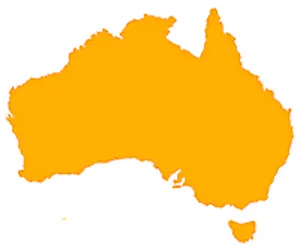
Photo: Echidna habitat map
Echidnas are incredibly adaptable and can be found in:
• Forests and woodlands
• Snow-covered mountains
• Deserts and arid zones
• Urban areas* (occasionally spotted in gardens and parks!)
They prefer hiding in hollow logs, burrows, or under leaf litter during the day and are most active during early morning and late afternoon. In hot environments, they shift to a nocturnal lifestyle to avoid overheating.
The short-beaked echidna lives in Australia and New Guinea, and the long-beaked echidna is only found in the highlands of New Guinea.
Echidna Diet: What Do Echidnas Eat?
Echidnas feed on insects and worms. These include: termites, ants, earthworms, beetles and larvae.
The echidna has no teeth. So, it uses hard keratin pads at the base of its tongue to push food up against the roof of its mouth and grinds its meal into a paste before swallowing. Since they lack a stomach, their food travels directly from the gullet to its intestines.
The echidna gets most of the water it requires from its diet. However, this is sometimes supplemented by drinking water or licking morning dew from plants and grasses.
The climate governs the echidna's feeding habits. In very hot weather, the echidna is nocturnal, only feeding at night. In cooler weather, it is diurnal, foraging in the morning and evening.
Echidna Reproduction: The Bizarre Mating Ritual
Echidnas are solitary animals and only socialise during the mating season from June to September.
• Up to 11 males form a "love train”, and follow a female in a line for days or weeks.
• The successful suitor is is the male who stuck closest to her the longest.
• The male echidna has a four-headed penis (yes, really!).
• Echidnas copulate (mate) by lying on their sides with their spineless undersides facing each other. Then, the male inserts his large four-pronged penis into the female’s cloaca for impregnation.
• The female lays a single leathery egg into her pouch 16 days after fertilization and incubates the egg for 7-10 days.
Baby Echidna (Puggle)
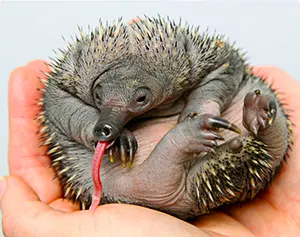
Photo: Echidna baby called a puggle
The the baby echidna is known as a puggle.
• It hatches after 10 days in its mother's pouch.
• It feeds on milk secreted through the mother’s skin (echidnas don’t have nipples!)
• When the puggle grows spines after 3 months, the mother removes it from her pouch and places it in a burrow.
• When the puggle is about 200 days old, the mother will dig out its nursery burrow opening and abandon the young puggle to fend for itself.
Echidnas Can Swim!
Despite their stubby legs, echidnas are excellent swimmers. They use a dog-paddling motion. Interestingly, unlike most land animals, the echidna swims with its head underwater, only lifting its beak above the waterline when it needs to take a breath.
How Echidnas Defend Themselves
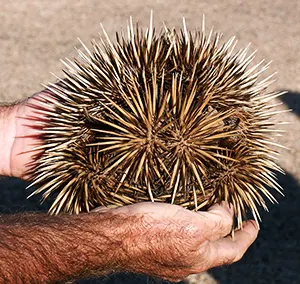
Photo: Echidna curled up in a ball with spines
Echidnas rely on multiple defence mechanisms:
• Camouflage: Their speckled brown colouring blends into their environment.
• Rolling into a Ball: If threatened, echidnas curl up, exposing only their sharp spines.
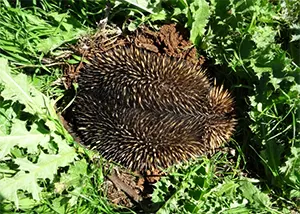
Photo: Echidna burying itself in the ground
• Burrowing: Using their strong claws, echidnas rapidly dig into the ground, becoming nearly impossible to dislodge.
• Wedging Under Rocks or Logs: They squeeze into tight spaces, protecting their soft underbellies.
Echidna Predators & Threats
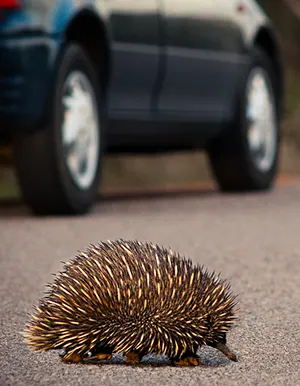
Photo: Echidna crossing a main road
The only native predator of adult echidnas is the Tasmanian Devil. However, baby echidnas sometimes fall victim to goannas — native monitor lizards who tear open their nursery burrow and capture spineless little puggles. Snakes, too, venture into nursery burrows and attack the young puggles. In addition, introduced animals such as dingoes, foxes, feral cats and dogs, are known to attack echidnas. Fortunately, the echidna's spiky defences offer it good protection, and these attacks are rarely successful.
Aborigines have been hunting echidnas since they arrived in Australia about 50,000 years ago. They have, however, had little impact on the overall survival of the echidna population. Since the arrival of European settlers in 1778, humans have significantly impacted the echidna population due to land clearing and forest felling. The echidnas, however, are adaptable animals and don't seem to have been seriously affected by these activities either.
Australian bushfires are the most significant single threat to an echidna. The echidna is too slow to run away. So instead of fleeing, it stays put and adapts a rather bizarre survival tactic.
How Echidnas Survive Bushfires
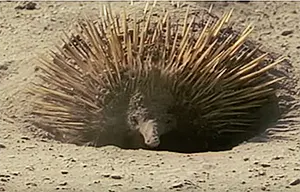
Photo: Echidna burying itself against a bushfire
Echidnas use a unique survival tactic against bushfires. Instead of fleeing, they burrow underground and enter a temporary state of torpor, slowing their metabolism and waiting for the danger to pass. Their spines provide additional insulation, protecting them from extreme temperatures.
Echidna Conservation Status
The echidna is quite common and not considered threatened. It is protected by Australian law.
How Did the Echidna Get its Name?
The name Echidna is pronounced ih-KID-na and is derived from the name for the Greek goddess Ekhidna who was half-snake and half-woman. The echidna's scientific name is Tachyglossus aculeatus, meaning "quick tongue and equipped with spines".
Echidna and the Mutiny on the Bounty

Photo: HMS Bounty
The first European to describe the echidna was none other than William Bligh, the captain of the sailing ship the HMS Bounty of Mutiny on the Bounty fame. The Bounty was on its way to Tahiti in 1792 when it stopped at Adventure Bay in Tasmania. There Bligh reported that the animal had a bill like a duck and a thick brown coat of hair with quills. A member of the crew shot an echidna and later roasted it, reporting that it had a "delicious flavour".
Echidnas: A True Australian Treasure
From their bizarre reproduction to their bushfire survival tricks, echidnas are among the most unique and resilient animals on Earth. As ancient survivors, they continue to captivate scientists and nature lovers alike.
Next time you spot one waddling through the bush, take a moment to appreciate this living fossil!
25 Echidna Facts
- The echidna is an egg-laying mammal. This is very unusual because mammals usually don't lay eggs.
- Echidnas are the oldest surviving mammal. Their prehistoric ancestors first appeared on earth about 220 million years ago.
- Its scientific name is Tachyglossus aculeatus, meaning quick tongue + equipped with spines. It is also referred to as a Spiny Anteater.
- The echidna is an example of what early mammals may have been like.
- They have roundish bodies covered with sharp beige and black spines up to 50mm long.
- However, unlike a porcupine whose quills detach and embed themselves in their attacker, an echidna's spines do not detach.
- They are somewhat similar in appearance to hedgehogs.
- There are only two species of echidna: the short-beaked echidna and the long-beaked echidna.
- Males and females are similar in appearance. But the male is about 25% larger than the female.
- The echidna has very poor eyesight. But it makes up for this with an excellent sense of hearing and smell.
- The echidna has no external ears but has funnel-like slits on either side of its head.
- It has a slender, elongated rubbery snout called a beak.
- From which it sticks out a long sticky tongue to catch its prey.
- Its tongue can flick in and out up to 100 times a minute.
- The echidna's diet consists of termites and ants.
- The echidna has no stomach. Instead, its gullet connects directly to its intestine.
- Echidnas have a body temperature between 31-32°C (88-89.5°F), which is 5- 8°C (41-46°F) lower than other mammals.
- To prevent overheating, the echidna blows snot bubbles from its nose that evaporates and cools the blood vessels just under its skin.
- Echidnas have one of the low metabolic rates among all mammals. During winter, they enter semi-hibernation, reducing their heart rate to only four beats per minute.
- It has only one rear opening called a cloaca. Other mammals have two.
- Echidnas have a small neocortex, the most recent part of the brain to evolve.
- The female echidna lays a small, leathery egg and places it in her pouch where the egg hatches.
- She has no nipples or teats like other mammals. Instead, it oozes milk through its skin and the baby laps it up.
- An echidna baby is called a puggle.
- The lifespan of an echidna is 15-40 years.
An Excerpt from the Original TrishansOz Page
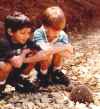
(Excerpt from the original TrishansOz page written in 1997 when Trishan was 11 years old.)
An echidna is about 50 cm long, and it is dome-shaped. It has short sharp spikes covering its body (like a porcupine). It has a short pointy snout and a sticky tongue with which it catches ants and termites. It has no teeth. The echidna has very sharp claws too and can burrow underground very quickly. An echidna has short stubby feet and waddles when it walks.
When it gets frightened, it raises its spikes to defend itself and tries to dig itself into the ground.
Echidnas adapt their activity according to the climate they are in. In hotter climates, they are nocturnal, coming out only during the cooler hours of the night. In cooler climates, they more diurnal, coming out during the day to forage for food.
You can see how the echidna is trying to hide in the photograph.
My dog Sage once tried to catch an Echidna and hurt his tongue.
Learn More About Australia's Incredibly Quirky Animals
All Rights Reserved. (Last Updated: May 28, 2025)
